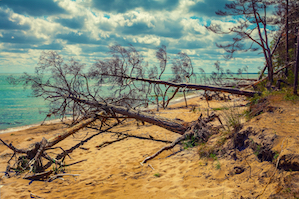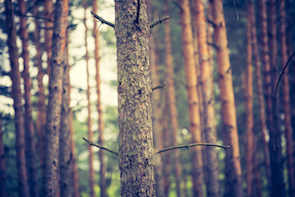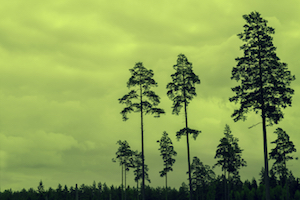The Natural Life and Removal of Pine Trees In Woodstock, GA
What Are The Life Stages Of The Longleaf Pine?
Of all of the varied Southern pine species, the Longleaf pine is the longest living variety. They may live as many as 250 years, though there are many that have exceeded that to at least 450 years old.
The Longleaf pine is referred to in various life stages, which refer as well to the overall forest in which it lives. Forests are constantly changing and may be experiencing any one of many stages at any time.
In general, the Longleaf forest will be considered a mature old growth arena even then nearly 66 percent of the trees will have reached less than 50 years of age.
Pine Tree Seed Stage
In fall, between October and November, the tell-tale winged seeds are sent to the forest floor. Once the seeds have made it to the ground, they are situated to receive and take on moisture.
This is key to their germination and may provide a great deal of potential for the next stage. Of course, there needs to be plenty of rain or moisture on the forest floor to support seed germination.
It is an either or situation with germination, as they are either going to receive the water they need or will dry out, wither, and die instead.
In general, though, seeds may take to almost any material from rocks to mulch to logs even. Though, having mineral-rich soil where they fall helps their survival exponentially.
The winged seeds are prone to dying, whether they are the victim of predators or fire. It can take one whole year for the seedlings to get to their next stage.
Grass Stage Of Pine Trees
In this next stage, the seeds will appear to be more like a grass, because they will be clumped together as a mass.
At this point, the bud for the future tree is kept from predators because of the thick grass of needles. While the rest of the needle may be prone to fire and burning, the bud is protected essentially. There are plenty of needles to replace the old ones.
Basically, the seedlings are able to withstand fire very effectively at this stage. This stage may last for up to 7 years. There have been some recorded instances of this stage lasting 20 years, where resources were available in small amounts over time.
It depends upon the competition for resources with other plant life combined with the availability of resources.
The key to the seedlings at this point is that they are starting to lay the groundwork for their roots. This is the very foundation of the long lifespan of the Longleaf pine.
Though, at this point the moisture can attract brown spot needle blight. This will cause the seedling to perish. 
Bottlebrush Is The Third Stage
The root collar hits a point where it grows to be one-inch thick. At this point, the grass stage gives way to the tree that begins to grow upward.
It will typically happen in late winter, from late February through to mid-March. The white tip, or candle, grows up and out of the grass of needles. At this point, the growth is rapid, occurring at a rate of up to a few feet within several months’ time.
Once late May arrives, by now the green needles emerge out of the candle and the tell-tale pine’s candle turns scaly in the formation of bark.
The growth is proportional in height at this point more so than anything else. Growing so fast means that the sapling is capable of maximizing sunshine and overcomes fire more aptly.
Though, if a fire does come during the bottlebrush stage, it is more vulnerable to fire. Within one or more years the bark will thicken sufficiently to withstand the vulnerability of fire. This stage lasts up to several years.
The Sapling
At the point of 6 feet in height up to 10 feet, the branches emerge in the sapling stage. While the bark thickens, the diameter grows as well.
The tree’s height increases at a rate of approximately three feet every year. Once February rolls through again, the growing tips show up in their upward growth out of the branches. While the tree grows taller, and the branches continue reaching outward, the bark thickens, which all makes it less vulnerable to fire.
Once the tree hits 8 feet tall and a 2-inch diameter it is rare that a Longleaf pine will succumb to fire. This stage occurs for several years.
The Pine Tree Matures
At or around the 30-year marker, the Longleaf will produce its own fertile seeds. When the forest matures around the tree, the lowest or lower limbs are more likely to shed or be burned by fire.
The trunk begins to reach a more filled out and straight formation that looks just like the Longleaf formation.
If the soil is fertile, a tree will continue pushing onward up to 110 feet. In a poorer soil, the tree will probably top off its growth at 60 feet or so. In the 70-year to 100-year period, the Longleaf pine will stop growing any taller.
Along the later stages of this one time period in the lifespan of a Longleaf pine, the tree might start to rot and decay even. At the 80-year marker, the tree may end up infected with a red heart fungus that infects the heart of the pine. This disease causes the pine to become soft, sappy, and filled with many tiny channels.
Old-Growth
At this point the tree has achieved a steady state. The largest diameter trees will have flat-topped crowns that poke out of the top of the forest.
There are some that exceed 120 feet in height and have expanded well beyond the 3-foot-diameter marker. At this point, if the tree has not ceased growth, it is likely it will now.
During advanced years, the trees will often stop growing. Though, of course, this tree has shown growth well into the 200-year marker. If the resources are available, the tree will continue to grow and flourish.
Depending on the forest, some 50 percent of all trees may be infected with the red-heart fungus.
The Death And Removal Of Pine Trees
 The fact that these trees are strong enough to endure through harsh and diverse conditions ranging from significant lightning strikes and volume to hurricane-strength winds and rain to tornadoes to snow and ice is incredible.
The fact that these trees are strong enough to endure through harsh and diverse conditions ranging from significant lightning strikes and volume to hurricane-strength winds and rain to tornadoes to snow and ice is incredible.
Yet, the longleaf pine is actually likely to die from old age at the 300-year marker. At that point the tree slowly begins to die, unable to contend with nature any longer.
The sign of death is when beetle activity makes its mark on the bark of the tree, while thinning of the needles is another significant sign of death. From there, actual death is defined once the full defoliation occurs.
After The Death
The contribution of this pine tree to the environment goes on long after its death. It is definitely not limited to the living tree alone. Yet, that is the case with this tree.
Its significance to the very ecosystem in which it once lived extends well beyond its death. After the tree dies, the bark comes off or is torn by woodpeckers, who are foraging for their meal. The snag or tree skeleton will eventually fall, though it can take up to several years for this to actually occur.
That rounds out the lifespan of this significant pine tree. It is capable of withstanding 300 years of mother nature before finally dying. Even then, it still remains significant to the forest around it.
For more information of Pine Tree removal please contact us today.




